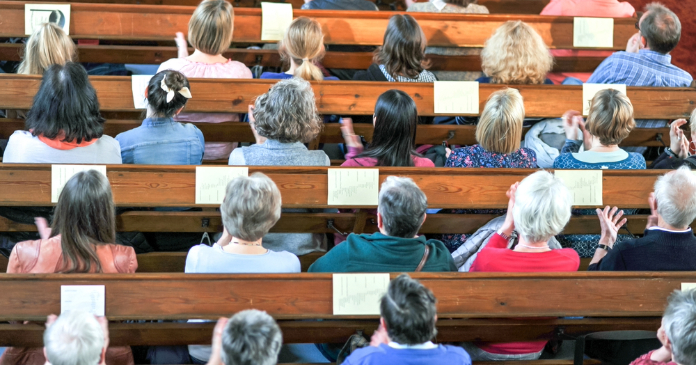
What makes for a “suitable hymn”? How should we gauge “good” and “bad” hymns? I would suggest using a very simple litmus test by asking this question: “Whom are we singing to?”
What is “good” Mass music? As a parish music director, I have often pondered this question. The Church gives clear instructions concerning the implementation of music within the Mass. For instance, the Church stipulates that the most important thing to be sung is the dialogue between the priest and the people: the Order of the Mass.
The next important thing is the Ordinary of the Mass (Kyrie, Gloria, Sanctus, etc.). The next thing sung should be the Propers (Introit, Responsorial Psalm [Gradual], Gospel Acclamation verse, Offertory antiphon, and Communion antiphon). The liturgical documents give provision for some of these proper antiphons to be replaced by “another suitable hymn.”
So, what makes for a “suitable hymn”? How should we gauge “good” and “bad” hymns? I would suggest using a very simple litmus test by asking this question: “Whom are we singing to?”
If the Mass is the highest form of worship to the One Almighty God and Lord of the Universe, shouldn’t our singing be directed especially toward Him? In recent decades, many published songs for Mass have been written with an orientation of me, myself, and I. The worship is not a vertical gaze toward Heaven. Rather, the orientation is a horizontal glance around the room.
By way of example: When singing the song, “Here I Am, Lord” by Dan Schutte, adorers in the pews sing with self-possessive language twenty-nine times, and they sing directly to God merely six times.
As another example, when singing a song like “Be Not Afraid” by Robert Dufford, worshippers are completely oriented toward themselves (twenty-four instances), never once addressing God directly. God is indeed in the song, but His lines have been assigned to us! “You shall cross the barren desert…’’ (God’s line); “Be not afraid. I go before you always.” (God’s line); “know that I am with you through it all” (God’s line).
This concept of speaking and singing in the place of God creates a peculiar worship orientation that is far too common in our modern Catholic music repertoire: We are taking God’s lines, and we are delivering them to ourselves. You may as well place a giant mirror on the altar.
As I considered this question of hymn orientation, I thought it would be interesting to dig a little deeper into the verbiage of our Catholic music within the United States. How often do we sing to ourselves and how often do we sing to God? The following data has been categorized by songs (non-hymnody) and hymns (strophic, stanza-based).
Here are the top ten songs (non-hymnody) from January 1 to June 30, 2024, in U.S. Catholic parishes, as reported by the royalty-reporting company OneLicense.net. Songs are listed by the instances of orientation: (1) “Me/myself/I” language, (2) “God/Lord” language:
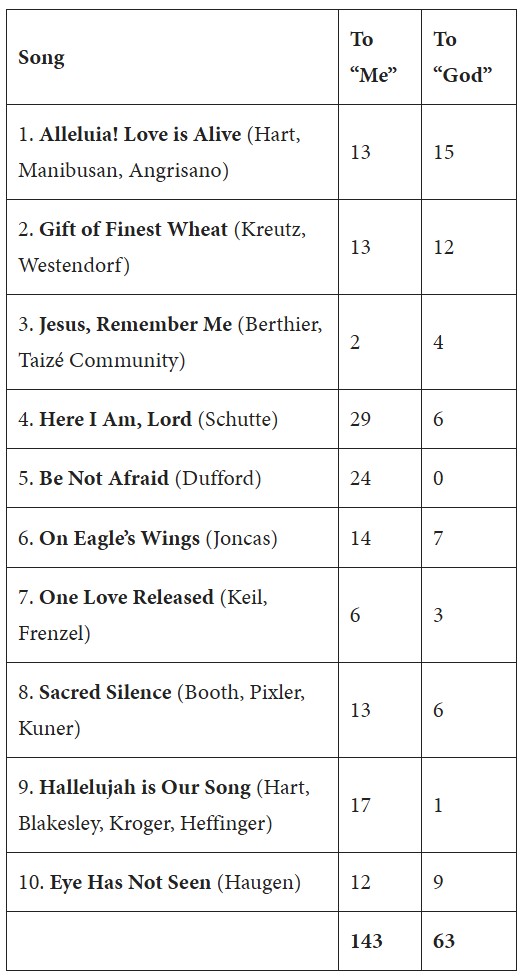
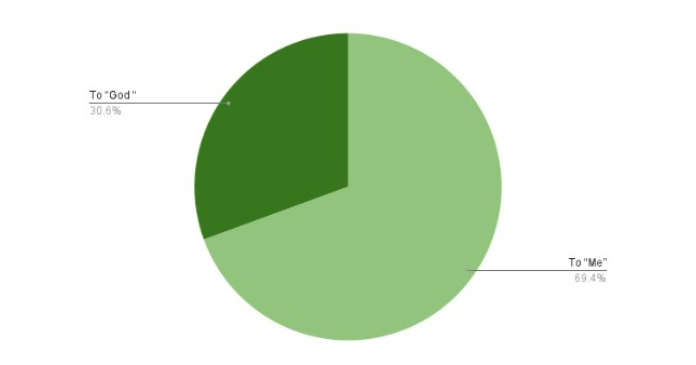
I have no doubt that these songs were composed with all sincerity of heart and mind. For this discussion, focusing on the topic of Mass orientation, it is simply worth noting that the aforementioned songs have worshippers singing about themselves more than twice as often as they sing about God!
Conversely, here are the top ten hymns (strophic, stanza-based) reported in U.S. Catholic parishes at the same time from OneLicense.net. (It’s worth noting that the following data for hymnody does not include all the public domain hymns that are often utilized within Catholic parishes, as public domain hymns do not require usage claiming. The text editions of these hymns were from the reported publishers OCP and GIA.)
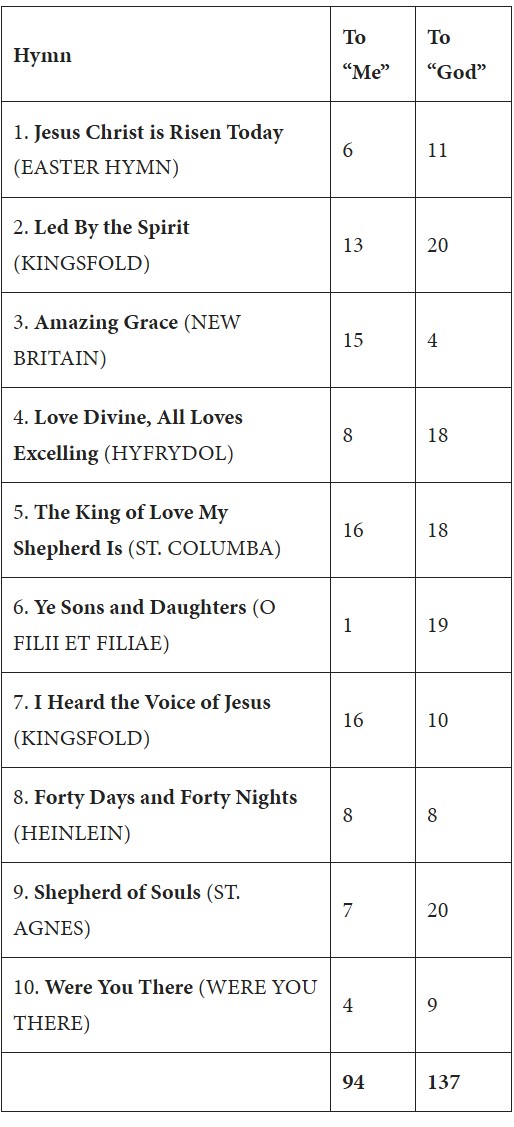
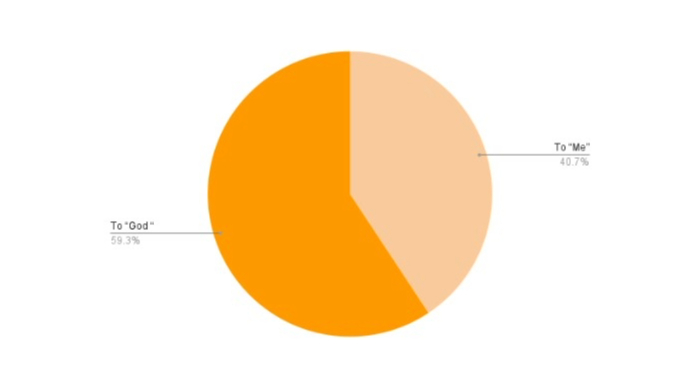
The music we choose for Mass plays a crucial role in shaping our worship experience. Liturgical music should prioritize music that focuses on a direct communication with God, helping to create a reverent and transcendent atmosphere for worship. However, the current trend of singing about ourselves rather than to God risks diminishing the vertical orientation of the Mass, shifting attention away from God and toward personal reflection.
I am reminded of Adam and Eve in the Garden of Eden. They were created without sin and lived in perfect union with God. Their gaze was fixed on the Lord and they “felt no shame” (Genesis 2:25). It was only after they sinned that they looked at themselves and noticed that they were naked (Genesis 3:7).
By gazing toward Heaven within our musical palette, we can continually look with anticipation to our great reunion with the Lord in Heaven.
Now, it is not my suggestion that we never sing about ourselves. After all, it is all of us on earth, the church militant, who are “working out our salvation with fear and trembling” (Philippians 2:12). The psalms often address the human perspective. The aforementioned Order, Ordinary, and Propers of the Mass often use the language of “me, myself, I.” I would nonetheless encourage an awareness to this grammatical subtly in the songs that are chosen within Catholic parishes.
Based on the data presented above, the parish music director can proceed with confidence by choosing the theologically sound hymns that have been sung by Catholics for generations. Notice that hymns listed above orient worshippers toward God 146 percent more than toward one’s self.
Think of the glorious words of praise as we sing, “to Jesus Christ, our Sovereign King!” Or the definitive declaration of Christ’s Presence in the Holy Eucharist as we sing, “Jesus, my Lord, my God, my all.” These hymns transmit a faith through clarity and theological precision. Most importantly, they direct our minds and bodies toward our very Source and Fount of life: Jesus Christ.
As we continue to evaluate the songs used in Catholic worship, we must ask ourselves: Are we truly singing to God, or are we singing about ourselves? By carefully selecting music that fosters a deeper connection with the divine, we can reclaim the sacredness of the Mass and restore its true focus on God’s glory.
